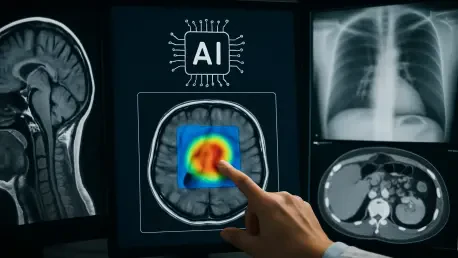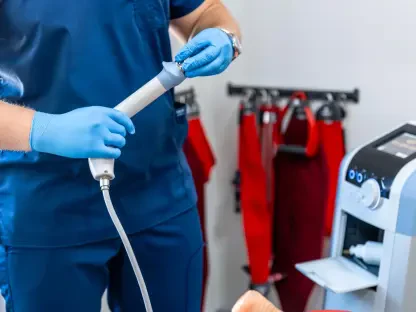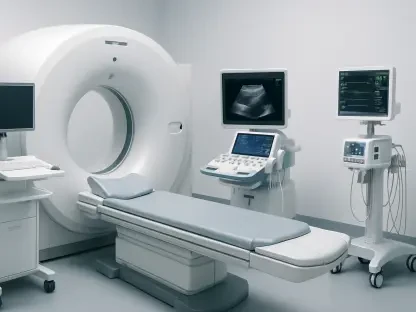Artificial intelligence (AI) is rapidly becoming a cornerstone of modern healthcare, especially in the critical field of medical image analysis, where it offers unprecedented support to overburdened medical professionals. Imagine a scenario where radiologists, stretched thin by an ever-growing number of diagnostic images to review, receive assistance from a tireless digital ally capable of interpreting complex chest X-rays with remarkable precision. This isn’t a distant dream but a reality being shaped by cutting-edge research, such as the pioneering work at CSIRO’s Australian e-Health Research Center (AEHRC). AI is stepping in to address systemic challenges like radiologist shortages and rising demand due to aging populations, particularly in regions like Australia. By automating routine tasks and enhancing diagnostic accuracy, this technology promises to reshape clinical workflows. This article explores how AI, through innovative tools and rigorous testing, is revolutionizing the way medical images are analyzed, ultimately aiming to improve patient outcomes.
Unleashing the Potential of Visual-Language Models
The driving force behind AI’s impact on medical image analysis lies in the development of visual-language models (VLMs), a significant advancement over earlier text-only AI systems. Unlike their predecessors, which focused solely on language processing, VLMs integrate visual recognition with linguistic understanding, allowing them to interpret intricate medical images like chest X-rays. These images are vital for diagnosing conditions such as heart disease, lung cancer, and even confirming the correct placement of medical devices like pacemakers. By generating detailed descriptions and draft reports from visual data, VLMs provide radiologists with a starting point that can save crucial time. At AEHRC, researchers are harnessing this technology to create tools that seamlessly fit into clinical environments, ensuring that the focus remains on augmenting human expertise rather than replacing it. This synergy between machine and human capabilities marks a transformative step in diagnostic efficiency.
Beyond their technical prowess, VLMs are being tailored to address specific healthcare challenges, particularly the overwhelming workload faced by radiologists. In regions with a pronounced shortage of specialists, the volume of imaging studies continues to surge, often outpacing the capacity of available professionals. The integration of VLMs into diagnostic processes offers a practical solution by automating preliminary analyses and flagging potential abnormalities for further review. Research spearheaded by experts like Dr. Aaron Nicolson at AEHRC demonstrates how these models can draft initial reports, freeing up specialists to concentrate on complex cases requiring nuanced judgment. This not only accelerates the diagnostic timeline but also reduces the risk of burnout among medical staff. As AI continues to evolve, its role as a supportive tool in medical imaging is becoming increasingly indispensable, paving the way for faster and more reliable patient care across diverse clinical settings.
Perfecting AI Through Rigorous Training
The effectiveness of AI in medical image analysis hinges on the meticulous training of visual-language models using expansive and diverse datasets. These models are exposed to thousands of X-ray images, paired with corresponding patient referrals and detailed radiology reports, to refine their ability to interpret visual data accurately. The process mirrors human learning, where repeated exposure and feedback lead to improved performance over time. At AEHRC, a distinctive approach involves enriching training data with additional patient information, such as records from emergency departments, vital signs, and medication histories. This contextual depth enables AI to produce reports that are not only precise but also clinically relevant, aligning closely with the nuanced needs of healthcare providers. Such advancements underscore the importance of comprehensive data in building AI tools that can truly support diagnostic workflows.
Equally critical to the training process is the continuous refinement of AI algorithms to adapt to real-world complexities. While large datasets form the foundation, the inclusion of varied patient scenarios ensures that models remain robust across different demographics and medical conditions. Researchers at AEHRC are focused on enhancing the adaptability of VLMs by integrating feedback loops where discrepancies in AI-generated outputs are analyzed and corrected. This iterative method helps in minimizing errors and boosts the reliability of automated reports, making them more trustworthy for radiologists to use as a reference. Furthermore, the emphasis on diverse data helps address potential gaps in representation, ensuring that the technology performs equitably for all patient groups. As training methodologies advance, the precision of AI in medical imaging is set to reach new heights, offering a scalable solution to the pressing demands of modern healthcare systems.
Navigating Ethical and Safety Considerations
As AI becomes more embedded in medical image analysis, ethical considerations take center stage to ensure its responsible deployment. A primary concern is the risk of bias in training datasets, which could lead to disparities in diagnostic outcomes across different populations if not carefully managed. Researchers at AEHRC are acutely aware of this challenge and prioritize strategies to mitigate such risks, ensuring that AI tools are developed with fairness in mind. Importantly, these systems are designed to function as assistive aids rather than autonomous decision-makers, preserving the critical role of human oversight. Radiologists remain integral to the process, reviewing AI outputs to make final clinical judgments, which helps maintain trust and accountability in patient care. This balance between technological innovation and ethical responsibility is essential for the credible integration of AI in healthcare.
Beyond bias, safety and transparency are paramount in the application of AI to medical diagnostics. The potential for errors in automated interpretations, though rare, necessitates rigorous validation to prevent misdiagnoses that could impact patient outcomes. To address this, development teams at AEHRC emphasize clear documentation of AI processes, enabling healthcare providers to understand and scrutinize the technology’s recommendations. Additionally, ongoing collaboration with clinical experts ensures that AI tools align with established medical standards and protocols. By fostering an environment where technology supports rather than dictates, the focus remains on enhancing patient safety while leveraging the efficiency of automated systems. As ethical frameworks continue to evolve alongside AI advancements, they provide a crucial safeguard, ensuring that the benefits of this technology are realized without compromising the integrity of medical practice.
Testing AI in Real-World Clinical Settings
The practical impact of AI in medical image analysis is being rigorously evaluated through real-world clinical trials, providing essential insights into its effectiveness. At facilities like Princess Alexandra Hospital in Brisbane, researchers are conducting comparative studies to assess AI-generated radiology reports against those produced by human specialists. These trials are designed to measure not only the accuracy of automated outputs but also their utility in streamlining workflows under actual clinical conditions. Early results indicate significant potential for AI to reduce diagnostic turnaround times, a critical factor in improving patient care. By identifying strengths and areas for improvement, such testing ensures that AI tools are refined to meet the specific needs of healthcare environments, reinforcing their role as reliable aids to radiologists.
Expanding the scope of these evaluations is a priority for researchers aiming to validate AI across a broader range of settings. Plans to include additional clinical sites for testing reflect a commitment to ensuring that the technology performs consistently in diverse contexts, from urban hospitals to regional clinics. This comprehensive approach helps uncover unique challenges, such as variations in imaging equipment or patient demographics, that could influence AI performance. Moreover, the feedback gathered from these trials is invaluable for fine-tuning algorithms and enhancing user interfaces to better integrate with existing systems. Beyond image analysis, the application of visual-language models to other tasks, like processing medical documents for efficient data retrieval as explored by Dr. Arvin Zhuang, highlights the versatility of AI in addressing multiple facets of healthcare operations, pointing to a future of interconnected technological solutions.
Paving the Way for Future Healthcare Innovations
Looking back, the journey of AI in medical image analysis has been marked by remarkable strides, with initiatives at AEHRC demonstrating how visual-language models evolved to interpret chest X-rays with increasing accuracy. Clinical trials conducted in settings like Princess Alexandra Hospital provided critical benchmarks, showing how AI supported radiologists by automating routine reporting tasks. Ethical frameworks developed during this period ensured that human oversight remained central, safeguarding patient trust while addressing potential biases in training data. These efforts collectively reduced the burden on specialists and improved diagnostic efficiency, setting a strong foundation for integrating technology into healthcare.
Moving forward, the focus should shift to scaling these innovations through broader clinical validations and partnerships across global healthcare systems. Stakeholders must prioritize accessible training programs for medical staff to ensure seamless adoption of AI tools. Additionally, continuous investment in refining algorithms with diverse datasets will be key to maintaining equity in diagnostic outcomes. As AI’s role expands beyond imaging to areas like document processing, a collaborative approach between technologists and clinicians will be essential to unlock its full potential, ultimately transforming patient care for generations to come.









